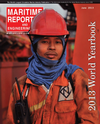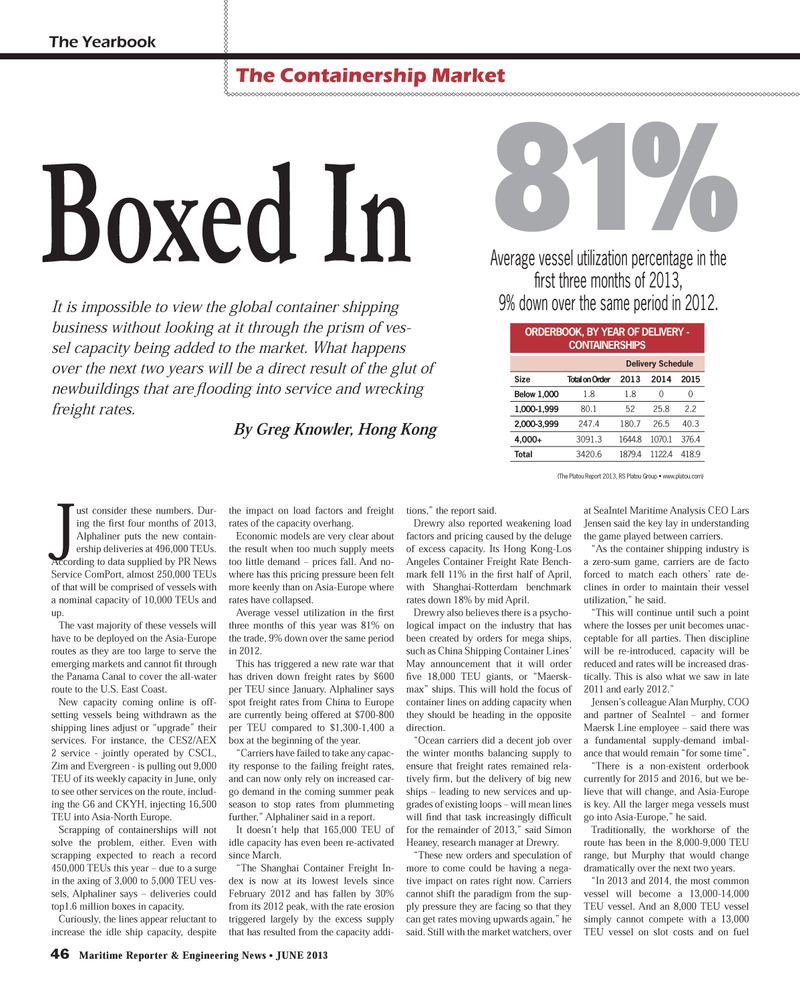
Page 46: of Maritime Reporter Magazine (June 2013)
Annual World Yearbook
Read this page in Pdf, Flash or Html5 edition of June 2013 Maritime Reporter Magazine
46 Maritime Reporter & Engineering News ? JUNE 2013 Just consider these numbers. Dur- ing the Þ rst four months of 2013, Alphaliner puts the new contain-ership deliveries at 496,000 TEUs. According to data supplied by PR News Service ComPort, almost 250,000 TEUs of that will be comprised of vessels with a nominal capacity of 10,000 TEUs and up.The vast majority of these vessels will have to be deployed on the Asia-Europe routes as they are too large to serve the emerging markets and cannot Þ t through the Panama Canal to cover the all-water route to the U.S. East Coast. New capacity coming online is off- setting vessels being withdrawn as the shipping lines adjust or ?upgrade? their services. For instance, the CES2/AEX 2 service - jointly operated by CSCL, Zim and Evergreen - is pulling out 9,000 TEU of its weekly capacity in June, only to see other services on the route, includ-ing the G6 and CKYH, injecting 16,500 TEU into Asia-North Europe. Scrapping of containerships will not solve the problem, either. Even with scrapping expected to reach a record 450,000 TEUs this year ? due to a surge in the axing of 3,000 to 5,000 TEU ves- sels, Alphaliner says ? deliveries could top1.6 million boxes in capacity. Curiously, the lines appear reluctant to increase the idle ship capacity, despite the impact on load factors and freight rates of the capacity overhang.Economic models are very clear about the result when too much supply meets too little demand ? prices fall. And no- where has this pricing pressure been felt more keenly than on Asia-Europe where rates have collapsed.Average vessel utilization in the Þ rst three months of this year was 81% on the trade, 9% down over the same period in 2012.This has triggered a new rate war that has driven down freight rates by $600 per TEU since January. Alphaliner says spot freight rates from China to Europe are currently being offered at $700-800 per TEU compared to $1,300-1,400 a box at the beginning of the year. ?Carriers have failed to take any capac-ity response to the failing freight rates, and can now only rely on increased car- go demand in the coming summer peak season to stop rates from plummeting further,? Alphaliner said in a report. It doesn?t help that 165,000 TEU of idle capacity has even been re-activated since March. ?The Shanghai Container Freight In-dex is now at its lowest levels since February 2012 and has fallen by 30% from its 2012 peak, with the rate erosion triggered largely by the excess supply that has resulted from the capacity addi-tions,? the report said.Drewry also reported weakening load factors and pricing caused by the deluge of excess capacity. Its Hong Kong-Los Angeles Container Freight Rate Bench-mark fell 11% in the Þ rst half of April, with Shanghai-Rotterdam benchmark rates down 18% by mid April. Drewry also believes there is a psycho-logical impact on the industry that has been created by orders for mega ships, such as China Shipping Container Lines? May announcement that it will order Þ ve 18,000 TEU giants, or ?Maersk- max? ships. This will hold the focus of container lines on adding capacity when they should be heading in the opposite direction.?Ocean carriers did a decent job over the winter months balancing supply to ensure that freight rates remained rela-tively Þ rm, but the delivery of big new ships ? leading to new services and up-grades of existing loops ? will mean lines will Þ nd that task increasingly dif Þ cult for the remainder of 2013,? said Simon Heaney, research manager at Drewry. ?These new orders and speculation of more to come could be having a nega-tive impact on rates right now. Carriers cannot shift the paradigm from the sup-ply pressure they are facing so that they can get rates moving upwards again,? he said. Still with the market watchers, over at SeaIntel Maritime Analysis CEO Lars Jensen said the key lay in understanding the game played between carriers.?As the container shipping industry is a zero-sum game, carriers are de facto forced to match each others? rate de- clines in order to maintain their vessel utilization,? he said. ?This will continue until such a point where the losses per unit becomes unac-ceptable for all parties. Then discipline will be re-introduced, capacity will be reduced and rates will be increased dras-tically. This is also what we saw in late 2011 and early 2012.? Jensen?s colleague Alan Murphy, COO and partner of SeaIntel ? and former Maersk Line employee ? said there was a fundamental supply-demand imbal-ance that would remain ?for some time?.?There is a non-existent orderbook currently for 2015 and 2016, but we be-lieve that will change, and Asia-Europe is key. All the larger mega vessels must go into Asia-Europe,? he said. Traditionally, the workhorse of the route has been in the 8,000-9,000 TEU range, but Murphy that would change dramatically over the next two years. ?In 2013 and 2014, the most common vessel will become a 13,000-14,000 TEU vessel. And an 8,000 TEU vessel simply cannot compete with a 13,000 TEU vessel on slot costs and on fuel The YearbookThe Containership MarketBoxed In It is impossible to view the global container shipping business without looking at it through the prism of ves- sel capacity being added to the market. What happens over the next two years will be a direct result of the glut of newbuildings that are ß ooding into service and wrecking freight rates. By Greg Knowler, Hong Kong Delivery ScheduleSizeT otal on Order 20132014 2015Below 1,0001.81.800 1,000-1,99980.15225.82.2 2,000-3,999247.4180.726.540.3 4,000+3091.31644.81070.1376.4Total 3420.61879.41122.4 418.9(The Platou Report 2013, RS Platou Group www.platou.com) ORDERBOOK, BY YEAR OF DELIVERY - CONTAINERSHIPS 81%Average vessel utilization percentage in the rst three months of 2013, 9% down over the same period in 2012.MR #6 (42-49).indd 46MR #6 (42-49).indd 465/30/2013 1:21:14 PM5/30/2013 1:21:14 PM

 45
45

 47
47
